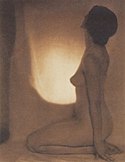The American annual of photography (1917) (14803915633)
Identifier: americanannualof1917newy (find matches)
Title: The American annual of photography
Year: 1917 (1910s)
Authors:
Subjects: Photography
Publisher: New York : Tennant and Ward
Contributing Library: Harold B. Lee Library
Digitizing Sponsor: Brigham Young University
View Book Page: Book Viewer
About This Book: Catalog Entry
View All Images: All Images From Book
Click here to view book online to see this illustration in context in a browseable online version of this book.
Text Appearing Before Image:
y, obtainable only in these mediums that raised them to the highest place. Why do not people make the most of their exhibition pictures by printing in these mediums, you ask? This I can not answer. Some say it is so easy to make a bromide enlargement and that is why these are in the great majority. But is it easy ?I venture to say that for every perfect bromide print exhibited five were discarded in the making. Yellow spots, blisters, grey lifeless prints and contrasty prints are a few of the troubles with which one has to contend. But take a perfect bromide print, its finest blacks can not compare with the rich vibrant black of a carbon print and the delicate, transparent shadows of a snow scene in platinum are represented by white paper in a bromide print. These are the arguments for adopting the noble mediums;the arguments against them are weak, to my mind, easily refuted. One must have a negative as large as the finished print is to be. In this day of the small camera this may seem too 200
Text Appearing After Image:
VIOLET ROMER. Edward Henry Weston. much trouble, but even if one does not make lantern slides it is well to make transparencies of ones best negatives in case the original becomes lost or broken. The transparency is as easy to make as a print; the enlarged negative no harder than an enlargement and once this is made prints can be turned out without further difficulty. One can work out defects very easily on the transparency too, and with no danger to the original negative. A soft focus lens can be used for making the enlarged negative, just as is often done in making bromide enlargements. The technical details for gum, carbon and platinum can be found in almost any magazine file. I can recommend the Photo-Miniature for platinum and carbon and Mr. P. L. Anderson's series of articles in American Photography about two years back is quite the best thing I have seen concerning gum. He covers every point fully and gives some of the theory too. A few words drawn from personal experience may not be amiss. P
Note About Images
Relevantní obrázky
Relevantní články
Edward WestonEdward Henry Weston byl americký fotograf a spoluzakladatel skupiny f/64. Je pokládán za „jednoho z nejmodernějších a nejvlivnějších amerických fotografů“ a „jednoho z mistrů fotografie 20. století“. Během čtyřicetileté kariéry Weston své cykly neustále rozšiřoval; vedle krajin, zátiší, aktů, portrétů či žánrových scén tvořil dokonce i náladové parodie. Přispěl k rozvoji „bytostně amerického, a zejména specificky kalifornského přístupu k moderní fotografii“, jelikož se zaměřil právě na obyvatele a krajinu amerického Západu. V roce 1937 Weston jako první z fotografů získal Guggenheimovo stipendium a v následujících dvou letech velkoformátovým fotoaparátem vyprodukoval téměř 1400 negativů. Na řadě svých nejslavnějších fotografií zachytil stromy a skály v kalifornské přírodní rezervaci Point Lobos poblíž místa, kde po mnoho let žil. Mezi jeho nejznámější fotografie patří například Paprika č. 30, Akt modelky Charis nebo Nautilus. Zpočátku byl pro jeho práce typický rukopis té doby – piktorialistická měkká kresba, po několika letech však tento styl opustil a stal se jedním z mistrů vysoce detailních fotografických obrazů. .. pokračovat ve čtení





















